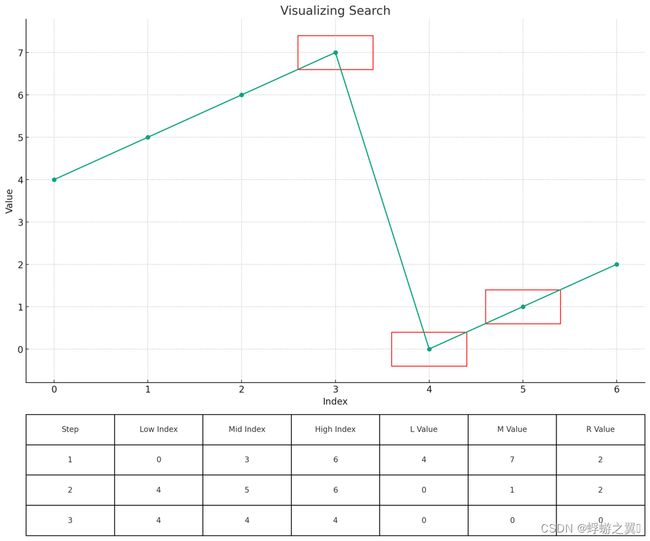Algorithms practice:leetcode 33. Search in Rotated Sorted Array
Algorithms practice:leetcode33 Search in Rotated Sorted Array
Description
There is an integer array nums sorted in ascending order (with distinct values).
Prior to being passed to your function, nums is possibly rotated at an unknown pivot index k (1 <= k < nums.length) such that the resulting array is [nums[k], nums[k+1], …, nums[n-1], nums[0], nums[1], …, nums[k-1]] (0-indexed). For example, [0,1,2,4,5,6,7] might be rotated at pivot index 3 and become [4,5,6,7,0,1,2].
Given the array nums after the possible rotation and an integer target, return the index of target if it is in nums, or -1 if it is not in nums.
You must write an algorithm with O(log n) runtime complexity.
Example
Example 1:
Input: nums = [4,5,6,7,0,1,2], target = 0
Output: 4
Example 2:
Input: nums = [4,5,6,7,0,1,2], target = 3
Output: -1
Example 3:
Input: nums = [1], target = 0
Output: -1
Constraints
Constraints:
1 <= nums.length <= 5000
-104 <= nums[i] <= 104
All values of nums are unique.
nums is an ascending array that is possibly rotated.
-104 <= target <= 104
code
class Solution {
public:
int search(vector<int>& nums, int target) {
int left =0;
int right = nums.size()-1;
while(left<=right)
{
int mid = (left+right)/2;
if (nums[mid] == target)
{
return mid;
}
if(nums[left] <=nums[mid]) // [left , mid] order subarray
{
if(nums[left] <=target && target< nums[mid])
{
right = mid-1;
}
else//( target> nums[mid] || target< nums[right])
{
left = mid+1;
}
}
else
{
// [mid , right] order subarray
if(nums[mid] <target && target<= nums[right])
{
left = mid+1;
}
else //( target> nums[mid] || target< nums[right])
{
right = mid-1;
}
}
}
return -1;
}
};
Oral process of solving problems
pivot index k = 0 0 1 2 3 4 5 6
pivot index k = 1 1 2 3 4 5 6 0
pivot index k = 2 2 3 4 5 6 0 1
pivot index k = 3 3 4 5 6 0 1 2
pivot index k = 4 4 5 6 0 1 2 3
pivot index k = 5 5 6 0 1 2 3 4
pivot index k = 6 6 0 1 2 3 4 5
pivot index k = 0 0 1 2 3 4 5 6

The problem requires a runtime complexity of O(log n), which can be achieved by using binary search. The main idea is to divide the search space into two halves using the middle element. If the middle element is the target, the process terminates. If not, we decide which subarray to continue the search in. The key to the problem is how to choose the subarray.
The ‘nums’ array may be rotated at an unknown pivot index ‘k’. The pivot indices are listed from 0 to 6 in the rotated arrays above. All possible rotated results can be seen. The origin array should be separated into two ascending arrays. If the array is split into two equal parts, there must be an ascending subarray.
For example, if the pivot index k = 2 [2 3 4 5 6 0 1],and target is 3, we select index 3 as the middle element.
The sub-array to the left of the middle item is [2 3 4 5], and the sub-array to the right of the middle item is [6 0 1].
The first sub-array is in ascending order, and we can determine if the target is in this array. In this case, the target is 3, which satisfies the conditions 2<3 and 3<5. Therefore, the target must be in this sub-array. If it is, we select this sub-array in the next iteration. Otherwise, we choose a different approach.
Therefore, to decide on a subarray, we must first find the subarray in order and check whether the target is in this array. If it is, we choose this subarray. If not, we choose another subarray.
now write code:
firstly, we declare two int variables as Pointers: a left pointer and a right pointer and assign 0 to left point ,assign nums.size()-1 to right point .
we declare
int left =0;
int right = nums.size()-1;
we use while loop. In each iteration , we check whether a subarray is order? if nums[left] <=nums[mid], the subarray from left to mid is order subarray. then if target in this subarray , we move right to mid -1. otherwise, we move left to mid+1
if above requirement is not meet, we can say the subarray from mid to right is order subarray. then if target in this subarray , we move left to mid+1. otherwise, we move right to mid -1…
Time Complexity: The time complexity is O(logn) since we’re performing a binary search over the elements of the array.
Space Complexity: The space complexity is O(1) because we only use a constant amount of space to store our variables (left\text{left}left, right\text{right}right, mid\text{mid}mid), regardless of the size of the input array.
words
Initialization is the process of assigning a value to the Variable. [2]
Declare and initialize a variable with an integer value [3]
binary search 二分搜索算法
terminate 终止(进程)
subarray
ascending
iteration迭代
pointer 指针
we declare two int variables 申明变量
assign 0 to left point 赋值
link
https://leetcode.com/problems/search-in-rotated-sorted-array/description/
- C++ Variables
- https://www.learncpp.com/cpp-tutorial/variable-assignment-and-initialization/
- https://www.codeease.net/programming/python/Declaration-and-Initialization-of-Variables
- https://leetcode.com/problems/search-in-rotated-sorted-array/solutions/3879263/100-binary-search-easy-video-o-log-n-optimal-solution/